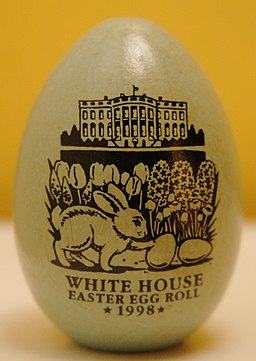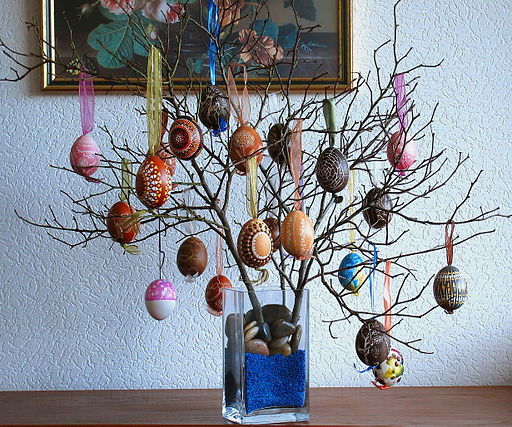This year for the Multicultural Kid Blogs Easter Around the World Blog Hop I thought I would focus on an aspect of Easter instead of Easter in a specific country. I chose to look at Easter eggs.
A Look at the History of Easter Eggs
Eggs have been a symbol of new life since ancient times, and they have been used in spring festivals long before Christianity existed. For thousands of years Iranians have decorated eggs to celebrate Nowruz, the Iranian New Year, that is on the spring equinox. Many Christians believe the egg to represent Jesus' emergence from the tomb and his resurrection. Some believe the use of Easter eggs may have been done by the Church to ease the transition for Pagans to Christianity. Others believe it came from the tradition of fasting during Lent. Eggs are on the list of foods that many gave up during Lent (and some Orthodox still do). To preserve the eggs laid by their chickens people would hard boil them and then when Lent was over they would distribute them especially to the poor who could not afford meat. Others believe that eggs became painted to mark the end of the fast at the end of Lent. It was a celebration to eat the decorated eggs on Easter morning. Decorating eggs goes back to at least the 13th century (but probably earlier). In Britain, Edward I bought 450 eggs to be colored or covered in gold foil and distributed to the royal entourage for Easter in 1290. Two years later the Vatican sent Henry VIII a silveregg, an egg in a silver case, as a seasonal gift.
Residents in 13th century English villages gifted eggs to their manorial lords every holiday. Eggs were also what people brought to church on Good Friday as a special offering. It is believed from evidence that eggs were dyed in the 16th and 17th century as gifts. They were often colored red, which is a color of joy. Others say the red represents the blood Jesus shed on the cross. Others paid their Easter dues with eggs even after the gentry switched to cash in the 18th century. In the late 19th and early 20th centuries, there was a switch in many holidays, including Easter, to make them more family-friendly. The dyed eggs were now given more to children rather than as payment or offering or even to the poor. The idea of egg hunts soon followed.
 |
| Easter Egg Hunt by Bobjgalindo [CC BY-SA 4.0], via Wikimedia Commons |
Easter Egg Activities & Customs
Egg hunts are very common where I live. It is where the eggs are hidden and the children search for them. In 1878 egg rolling came to the United States White House. It was brought to the United States by European immigrants.
 |
| White House Easter Egg Roll by dbking [CC BY 2.0], via Wikimedia Commons |
In Greece tsougrisma or egg tapping is often "played" on Easter morning. Each person has a hard boiled and decorated egg and they tap the small ends or large ends of the eggs until one cracks. The non-cracked eggs move on until there is only one egg left.
 |
| Egg Tapping by Superbass [CC BY-SA 3.0], via Wikimedia Commons |
In Germany there is a tradition to decorate trees or branches with Easter eggs. The tradition of Easter egg trees have spread to other areas that have German influence. Another tradition in Germany is Osterbrunnen. This tradition is decorated the public wells and fountains with Easter eggs. These displays usually last from Good Friday through two weeks after the holiday. There are also egg eating contests in Western Germany. Some parts of Germany also have egg throwing games where hard boiled eggs are thrown as far as they can be in a field. This is repeated many times over until the egg cracks.
 |
| Easter Egg Tree by Goldi64 [CC BY-SA 3.0], via Wikimedia Commons |
Easter Eggs Around the World
In Poland they boil the eggs with natural dyes like onion skins, juice of beets, and other natural items to dye the eggs.
 |
| Onion Skin Dyed Eggs with Other Dyed Eggs by L.Kenzel [CC BY-SA 3.0], via Wikimedia Commons |
In Bulgaria they decorate eggs with paints, herbs and wax. However the first egg is always dyed bright red. It is rubbed on the foreheads and cheeks of the children in the house and it is left at the front of the house for a year. The next year it is cracked open to predict the family's luck. If it is rotten so is the family's luck. If it is dry, it is good luck.
 |
| Easter Eggs from Bulgaria by Dimitǎr Boevski [CC BY-SA 4.0], via Wikimedia Commons |
 |
| Easter Eggs in front of the Zagreb cathedral by Diego Delso [CC BY-SA 3.0], via Wikimedia Commons |
 |
| Eggs in Croatia by Frka [CC BY-SA 3.0], via Wikimedia Commons |
In Ukraine as well as many other countries, the eggs are intricately decorated. The technique is called Pysanky or Pysanka. The design is drawn on the eggs before they are dyed.
 |
| Ukrainian Pysanky 2011 by Lubap Creator:Luba Petrusha [CC BY-SA 3.0], via Wikimedia Commons |
 |
| Easter Eggs in Greece by Tony Esopi [CC BY-SA 3.0], via Wikimedia Commons |
 |
| German Osterei by Silar [CC BY-SA 4.0], via Wikimedia Commons |
In several countries leaves and flowers are used to create designs while dying the eggs.
 |
| Easter Eggs in Slovenia by Kaja Avberšek from Velenje - Ljubljana, Slovenija [CC BY 2.0], via Wikimedia Commons |
In Mexico they have cascarones. A cascarón is a hollowed out egg shell that is decorated and filled with confetti or toys. Talk about a celebration!
 |
| Cascarones by Luisfi [CC BY-SA 3.0], via Wikimedia Commons |
There are so many different traditions and beautiful eggs out there. This is just a sampling of some of the more unique ones. You can see more about Easter eggs from around the world at these posts: Easter in Ukraine and Russia, Easter in France, Easter Around the World: Germany, Hungary, Norway and Poland, Making Portuguese Sweet Bread, Easter in France, Spain, and Portugal, and Easter Around the World: Sweden.
Sources:
- Barooah, Jahnabi. Huffpost. “Easter Eggs: History, Origin, Symbolism And Traditions.” (02 Apr 2012) https://www.huffpost.com/entry/easter-eggs-history-origin-symbolism-tradition_n_1392054
- Gabbatt, Adam. The Guardian. “Easter Egg-Rolling: How a European Game Hatched on the White House Lawn.” (06 Apr 2015) https://www.theguardian.com/lifeandstyle/2015/apr/06/easter-egg-rolling-white-house-europe-tradition
- Gill, Omaira. Greece Is. “How to Win at Greek Egg Tapping.” (22 Apr 2016) http://www.greece-is.com/article/win-greek-egg-tapping/
- History.com Editors. “Easter Symbols and Traditions.” (27 Oct 2009)
- Little, Amanda. Great Value Vacations. “Beautiful Easter Eggs from Around the World.” https://www.greatvaluevacations.com/travel-inspiration/easter-eggs-around-the-world
- Ryan. Tinselbox. The Easter Egg – Truly Inspired from Around the World. (29 Feb 2016) https://www.tinselbox.com/easter-eggs-inspired-decorating/
- Waxman, Olivia B. Time. “Here’s Why Easter Eggs Are a Thing.” (14 Apr 2017) http://time.com/4732984/easter-eggs-history-origins/
- Wikipedia. “Cascarón” https://en.wikipedia.org/wiki/Cascar%C3%B3n
- Wikipedia. “Easter Egg Tree” https://en.wikipedia.org/wiki/Easter_egg_tree
- Wikipedia. “Osterbrunnen” https://en.wikipedia.org/wiki/Osterbrunnen
- Wikipedia. “Traditional Easter Games and Customs” https://en.wikipedia.org/wiki/Traditional_Easter_games_and_customs
Easter is approaching, and once again we are excited to take you on a tour of the world and how it celebrates Easter! Explore the diverse traditions of Easter with us, and don't miss our series from last year, or from 2017, 2016 or 2015. You also will enjoy this wonderful overview of global Easter traditions. Find these posts and more on our Easter Around the World Pinterest board: Follow Multicultural Kid Blogs's board Easter Around the World on Pinterest.
Participating Blogs


